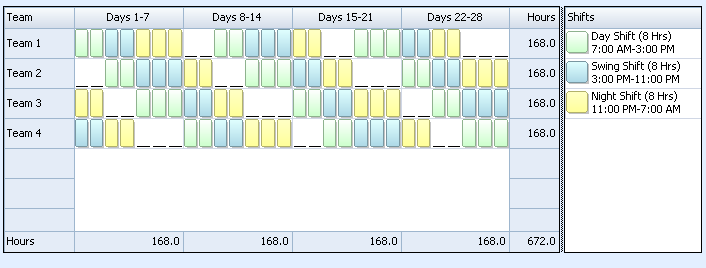The Continental shift schedule is a fast rotating shift pattern that uses 4 teams and three 8-hr shifts to provide 24/7 coverage. Each team rotates through a sequence of 2, 2, and 3 consecutive day shifts, swing shifts, night shifts, or days off. The following is a typical team schedule for a 4-week (28 days) repeat cycle:
- Week 1: 2 day shifts, 3 swing shifts, 2 night shifts
- Week 2: 2 days off, 3 day shifts, 2 swing shifts
- Week 3: 2 night shifts, 3 days off, 2 day shifts
- Week 4: 2 swing shifts, 3 night shifts, 2 days off

Notes:
The above grid shows working and non-working days for each team in one repeat cycle. Day 1 usually starts on a Monday but it can be any day of the week. At the end of the cycle, the entire sequence starts over. Color coded blocks represent assigned shifts (working days) while underlines represent non-working days.- The required shifts and shift lengths are shown in the Shifts column. Shift names, start times, and end times are shown as examples only. They can be changed to match the requirements of your operation.
- The teams required by the plan are shown in the first column. The total working hours for each team over the repeat cycle are shown in the Hours column, assuming one employee per team.
- The last row, Hours, shows the hours worked by all teams in each date range block (leg), assuming one employee per team.
Although Continental Shiftpopular in shiftwork, the transition between the day oriented circadian physiology and the requirement for work and sleep at the “wrong” biological time of day may cause sleep loss, fatigue, and shift work disorder.
When emergencies arise and an employee needs to take a few days off, it can be a challenge finding a replacement to ensure adequate shift coverage while taking into consideration time-off constraints, union, labor and overtime rules, employee availability, skills, preferences, etc. Snap Schedule 365 employee scheduling software solves these challenges and help companies build smarter schedules, avoid unnecessary overtime, and always know who is working where and when. Get your free trial now.
Characteristics |
|
| Plan ID | C4TR08-1 |
|---|---|
| Name | Continental Plan, also referred to as the 2-2-3 Rota |
| Applicability | 24/7 operations |
| Teams Required | 4 |
| Shifts | Day (8-hr), Swing (8-hr), Night (8-hr) |
| Repeat Cycle | 28 days |
| Rotation | Fast, forward rotation from day shift to swing shift to night shift |
| Average Hours per Week | 42 |
| Staffing Fluctuation | Balanced from shift to shift and day to day |
| Pluses |
|
| Minuses |
|
| Common Usage | Popular with 24/7 operations that prefer 8-hr shifts |
| Notes | This is an alternative to the Metropolitan plan for 24/7 operations using 8-hr shifts. It provides up to 3 consecutive days off and ensures 1 free weekend every 4 weeks. Its main drawback is the long 7 consecutive work days. |
Definitions:
- Plan ID: A code used to uniquely identify the shift plan in Snap Schedule employee scheduling software.
- Name: The name of the shift plan.
- Applicability: The type of operations this shift configuration is designed for.
- Teams Required: The number of teams (crews) required by this plan. A team may consist of one or more employees.
- Shifts: The different shifts used in this shift pattern. For each shift, only the shift description and shift length are shown. The shift start or end time can be adjusted to fit your business operations so long as the shift length stays the same.
- Repeat Cycle: The number of days required for each team to complete its assigned shift sequence in a schedule plan. At the end of each repeat cycle, the team starts the same shift sequence over again.
- Rotation: For rotating shift configurations, a team rotates from one shift to another according to a specific arrangement. In a forward rotation, the team rotates from a shift that starts earlier in the day to a shift that starts later in the day, e.g. Day to Swing to Night. In a backward rotation, the reverse is true. Many studies suggest that forward rotation is better than backward rotation since our body adjusts much better to changes in work shifts from earlier to later. The rotation speed is the speed at which the shifts are rotated. In a "fast" rotation, a team rotates from one shift to another once every few days or less. In a "slow" rotation, a team works the same shift for many days or weeks before rotating to another shift.
- Average Hours Per Week: This is the average number of hours worked by each employee per week based on the shift lengths and shift sequences for this plan.
- Staffing Fluctuation: The fluctuation in staffing level as the plan progresses from shift to shift and day to day. A shift configration is "balanced from shift to shift" if the new shift will be staffed by the same number of employees as the old shift. A shift configuration is "balanced from day to day" if each day is staffed by the same number of employees. Note that by default, each team contains the same number of employees.
- Pluses: Positive aspects of the shift configuration.
- Minuses: Negative aspects of the shift configuration.
- Common Usage: Typical users of the shift configuration.